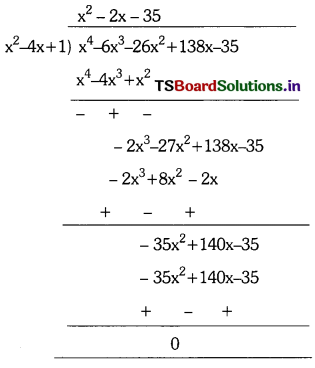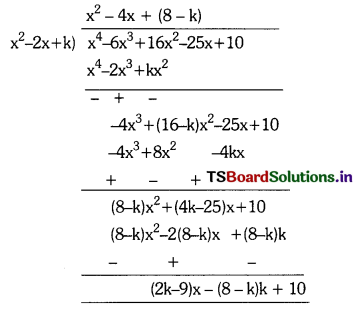Students can practice TS 10th Class Maths Solutions Chapter 3 Polynomials Optional Exercise to get the best methods of solving problems.
TS 10th Class Maths Solutions Chapter 3 Polynomials Optional Exercise
Question 1.
Verify that the numbers given along side the cubic polynomials below are their zeroes. Also verify the relationship between the zeros and the coefficients in each case :
i) 2x3 + x2 – 5x + 2;(\(\frac{1}{2}\), 1, -2)
ii) x3 + 4x2 + 5x – 2; (2, 1, 1)
Solution:
i) Given polynomial is 2x3 + x2 – 5x + 2
Comparing the given polynomial with ax3 + bx2 + cx + d,
We get a = 2, b = 1, c = -5 and d = 2
p(\(\frac{1}{2}\)) = 2(\(\frac{1}{2}\))3 + (\(\frac{1}{2}\))3 – 5(\(\frac{1}{2}\)) + 2
= \(\frac{1}{4}\) + \(\frac{1}{4}\) – \(\frac{5}{2}\) + \(\frac{2}{1}\)
= \(\frac{1+1-10+8}{4}\) = \(\frac{0}{4}\) = 0
P(1) = 2(1)3 + (1)2 – 5(1) + 2
= 2 + 1 – 5 + 2 = 0
p(-2) = 2(-2)3 + (-2)2 – 5(-2) + 2
= 2(-8) + 4 + 10 + 2
= -16 + 16 = 0
∴ \(\frac{1}{2}\), 1, and -2 are the zeroes of 2x3 + x2 – 5x + 2
So, α = \(\frac{1}{2}\), β = 1 and γ = -2
Therefore,
α + β + γ = \(\frac{1}{2}\) + 1 + (-2)
= \(\frac{1+2-4}{2}\) = \(\frac{-1}{2}\) = \(\frac{-b}{a}\)
αβ + βγ + γα = (\(\frac{1}{2}\))(1) + (1)(-2) + -2(\(\frac{1}{2}\))
= \(\frac{1}{2}\) – 2 – 1
= \(\frac{1-4-2}{2}\) = \(\frac{-5}{2}\) = \(\frac{c}{a}\)
And αβγ = \(\frac{1}{2}\) × 1 × (-2) = -1 = \(\frac{-2}{2}\) = \(\frac{-\mathrm{d}}{\mathrm{a}}\)
ii) Given polynomial is x3 – 4x2 + 5x – 2
Comparing the given polynomial with ax3 + bx2 + cx + d, We get a = 1, b = -4, c = 5 and d = -2
p(2) = (2)3 – 4(2)2 + 5(2) – 2
= 8 – 16 + 10 – 2 = 0
p(1) = (1)3 – 4(1)2 + 5(1) – 2
= 1 – 4 + 5 – 2 = 0
∴ 2, 1 and 1 are the zeroes of x3 – 4x2 + 5x – 2.
So, α = 2, β = 1 and γ = 1
Therefore,
α + β + γ = 2 + 1 + 1
= 4 = \(\frac{-(-4)}{1}\) = \(\frac{-b}{a}\)
αβ + βγ + γα = 2(1) + (1)(1) + (1) (2)
= 2 + 1 + 2 = 5
= \(\frac{5}{1}\) = \(\frac{c}{a}\)
and
αβγ = (2) (1) (1) = 2 = \(\frac{-(-2)}{1}\) = \(\frac{-\mathrm{d}}{\mathrm{a}}\)
Question 2.
Find a cubic polynomial with the sum, sum of the product of its zeroes taken two at a time and the product of its zeroes as 2, -7, -14 respectively.
Answer:
Let the cubic polynomial be
ax3 + bx2 + cx + d and its zeroes be α, β and γ.
Then
α + β + γ = 2 = \(\frac{-(-2)}{1}\) = \(\frac{-b}{a}\)
αβ + βγ + γα = -7 = \(\frac{-7}{1}\) = \(\frac{c}{a}\)
and αβγ = -14 = \(\frac{-14}{1}\) = \(\frac{-d}{a}\)
∴ a = 1, b = -2, c = -7 and d = 14.
So, one cubic polynomial which satisfies the given conditions will be
x3 – 2x2 – 7x + 14
![]()
Question 3.
If the zeroes of the polynomial x3 – 3x2 + x + 1 are a – b, a, a + b, find a and b.
Answer:
Given polynomial is x3 – 3x2 + x + 1
Since, (a – b), a, (a + b) are the zeroes of the polynomial x3 – 3x2 + x + 1.
Therefore, sum of the zeroes = (a – b) + a + (a + b)
⇒ 3a = 3 ⇒ a = 1
= \(\frac{-(-3)}{1}\) = 3
∴ Sum of the products of its zeroes taken two at a time.
= a(a – b) +a(a + b) + (a + b) (a – b)
= \(\frac{1}{1}\) = 1
⇒ a2 – ab + a2 + ab + a2 – b2 = 1
⇒ 3a2 – b2 = 1
So, 3(1)2 – b2 = 1
⇒ 3 – b2 = 1
⇒ b2 = 2 ⇒ b = \(\sqrt{2}\) = ±\(\sqrt{2}\)
Here, a = 1 and b = ±\(\sqrt{2}\)
Question 4.
If two zeroes of the polynomial x4 – 6x3 – 26x2 + 138x – 35 are 2 ± \(\sqrt{3}\) , find other zeroes.
Answer:
Given polynomial is
x4 – 6x3 – 26x2 + 138x – 35
We have, 2 ± \(\sqrt{3}\) are two zeroes of the polynomial
p(x) = x4 – 6x3 – 26x2 + 138x – 35
Let x = 2 ± \(\sqrt{3}\)
So, x – 2 = ±\(\sqrt{3}\)
On squaring, we get x2 – 4x + 4 = 3, i.e., x2 – 4x + 1 = 0
Let us divide p(x) by x2 – 4x + 1 to obtain other zeroes

p(x) = x4 – 6x3 – 26x2 + 138x – 35
= (x2 – 4x + 1) (x2 – 2x – 35)
= (x2 – 4x + 1) (x2 – 7x + 5x – 35)
= (x2 – 4x + 1) [x(x – 7) +5(x – 7)]
= (x2 – 4x + 1) (x + 5) (x – 7)
So, (x + 5) and (x – 7) are other factors of p(x)
So, -5 and 7 are other zeroes of the given polynomial.
![]()
Question 5.
If the polynomial
x4 – 6x3 – 16x2 + 25x + 10 is divided by another polynomial x2 – 2x + k, the remainder comes out to be x + a, find k and a.
Answer:
Given polynomial is
x4 – 6x3 + 16x2 – 25x + 10 and another polynomial is x2 – 2x + k
Remainder is x + a
Let us divide
x4 – 6x3 + 16x2 – 25x + 10 by x2 – 2x + k.

∴ Remainder = (2k – 9)x – (8 – k)k + 10
But the remainder is given as x + a.
On comparing their coefficients we have
2k – 9 = 1 ⇒ 2k = 10
⇒ k = 5 and -(8 – k) k + 10 = a
So, a = -(8 – 5) 5 + 10 = -3 × 5 + 10
= -15 + 10 = -5
Hence, k = 5 and a = -5